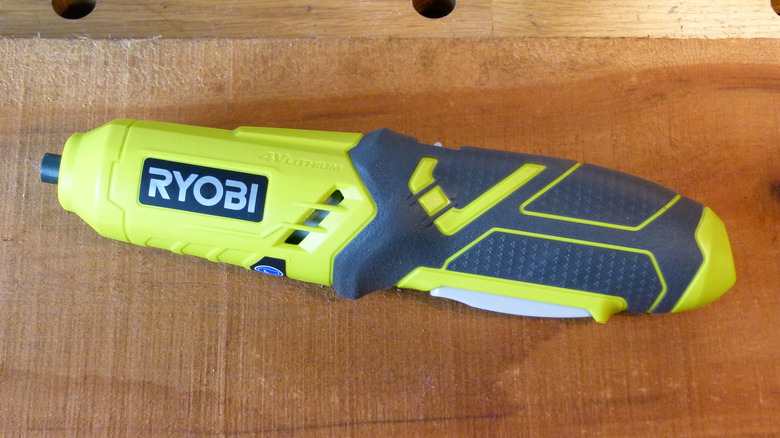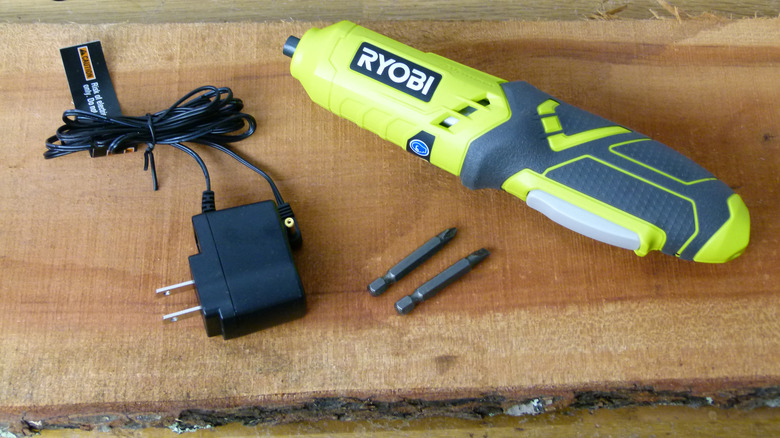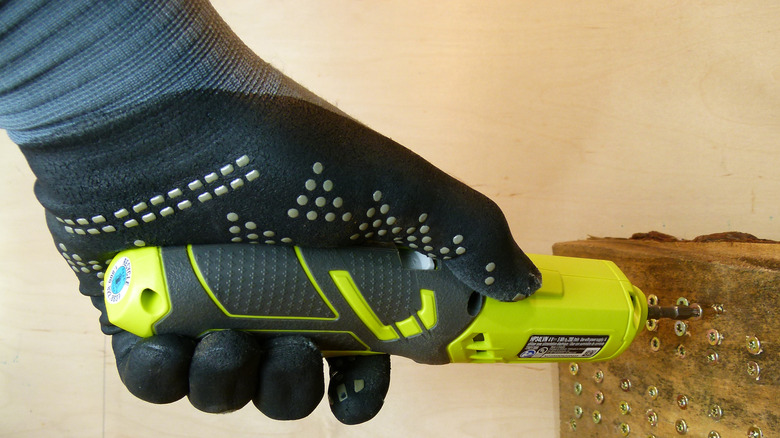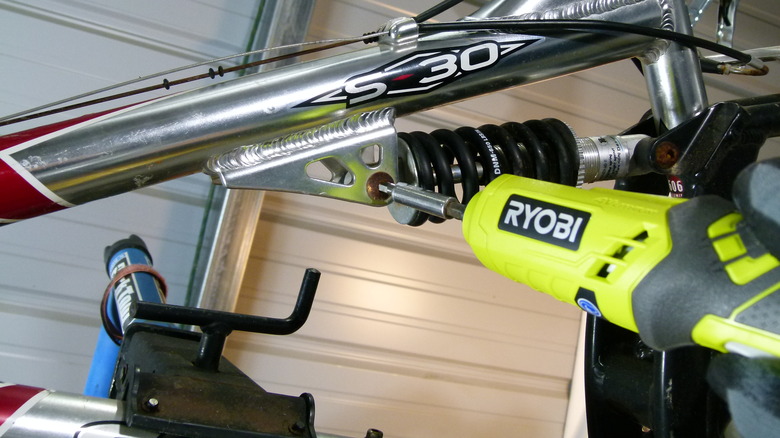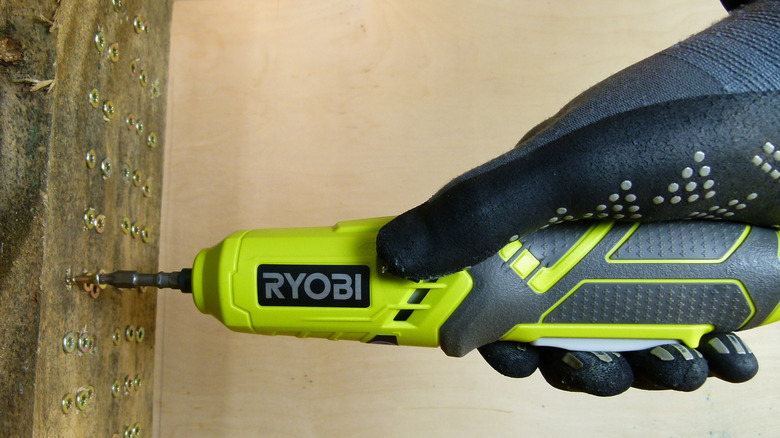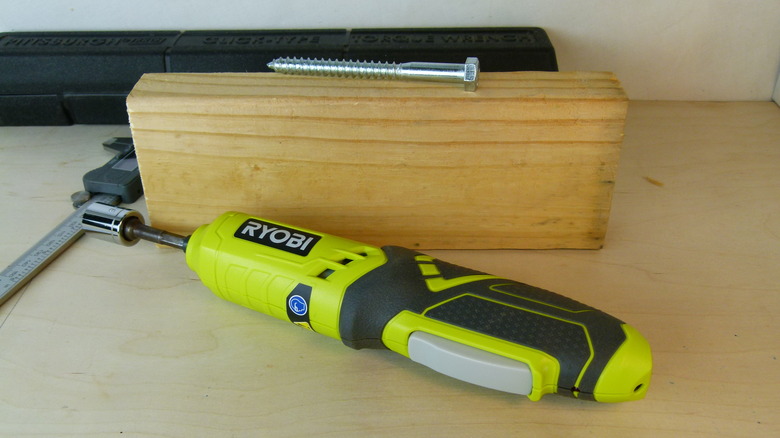We Tried The Cheapest Electric Screwdriver At Home Depot. Here's How It Went
We may receive a commission on purchases made from links.
Electric screwdrivers occupy an odd position in the home improvement DIYer's toolbox. The less experienced — the reluctant fixers, hangers of curtain rods, mounters of the occasional under-counter LED fixture — tend to have them, while others lug around more capable (and spectacularly more expensive) drills and impact drivers that are overkill most of the time. Electric screwdrivers are designed to drive screws, unsurprisingly, mostly in situations when a manual screwdriver would be too much effort. They're not meant for drilling holes or for screwing into metal or thick hardwoods.
Cordless screwdrivers can be an affordable option, if you stick to basics and avoid those made ... or at least priced ... for pros, like Milwaukee, DeWalt, etc. Enter the Ryobi HP34L 4-volt Lithium Screwdriver. At $19.97, it's the cheapest cordless screwdriver in Ryobi's line and the cheapest option at our nearest Home Depot. There are comparable screwdrivers on the market from Black & Decker, Skil, Wen, and others, but the Ryobi is exclusive to Home Depot and better-reviewed than its competitors. Our Home Depot also stocks more expensive electric screwdrivers from Ryobi, Milwaukee, and Dremel ranging from $25 to $99.
The Ryobi HP34L is locked in Home Depot's battery-operated tools section along with its more full-featured siblings (the HP44L and HP54L) and other, far more expensive tools. It seems happily out of place, like the family who buys the cheapest house in a gated community, and it might just be one of the few sensible purchases in the neighborhood.
A closer look at the Ryobi HP34L
Called everywhere the "Ryobi 4V Lithium Screwdriver," the HP34L is a simple tool designed to do a simple job reasonably well. The built-in 4V lithium-ion battery, while not quite as powerful (or safe) as newer lithium-polymer batteries, is good for an inexpensive screwdriver. It's a single Samsung cell, rated at 3.7 volts and 1.5 Ah in its Materials Safety Data Sheet. It has a ¼-inch non-locking hex collet, meaning that standard driver bits can be inserted and removed without engaging a locking mechanism. Additionally, the screwdriver has a forward-locked-reverse selection switch and a large "two-finger trigger." It's also described as compact with a GripZone over-mold to help you hang onto it when things get sweaty and twisty. Interestingly, though it's not really mentioned anywhere else, the product's manual adds "light-duty drilling" to its official screwdriving abilities.
The HP34L has no torque controls, no LED work lights, and no adjustable handle (meaning it's a straight screwdriver with no pistol grip option). Amazon specs the drill at 200 RPM with 40 inch-pounds of torque, weighing in at 14.4 ounces. The more expensive Ryobi offerings have a 200/600 RPM selector switch, but higher drill/driver speeds usually come at the expense of lower torque, which can be a problem in what are already low-powered devices. There also is no battery level indicator. It comes with #2 Phillips bit and SL6 slotted driver bits, both 2 inches long. Ryobi recommends 1- and 2-inch hex bits.
How we tested the Ryobi HP24L Lithium Screwdriver
To learn about the battery's longevity and the speed, torque, and handling of the screwdriver, we started by driving number 8 1-⅝-inch yellow, zinc-plated construction screws into two sandwiched 1-inch cutoffs of fairly wet rough-cut pine. The screws have a Type 17 point, which reduces the torque required to sink them, and a T-25 Torx head to eliminate driver slippage.
We started by driving 40 screws, assuming this would be about the screwdriver's limit. We did not drill pilot holes, but did dimple the location with a center punch to help space things evenly and not waste much battery starting screws. We rested the driver for a few minutes after every tenth screw to avoid over-taxing and possibly damaging the battery. We ended the test when the driver could no longer fully sink a screw.
After fully recharging the battery (an overnight affair), we attempted to drive a 4-inch-long ⅜-inch lag screw into the edge of a 2x4 scrap. This is not really a reasonable application of a 4V screwdriver, and the HP34L only managed to sink the screw about 1 inch, so we tried in two other spots along the board and achieved 1.25 inch and 1 inch. We also tested the light-duty drilling capability by drilling into a 2x4 with various drill bits with ¼-inch hex shanks. And, finally, we made some normal use of the tool, such as replacing the coil spring on a rehabbed mountain bike.
What the Ryobi HP34L did well
Our test results were mixed, but generally better than expected. The tool was comfortable and its GripZone finish seemed to help. As some reviewers on the Home Depot website suggested, the driver would occasionally twist one's arm when the strength used to prevent this was weaker than the resistance of the piece being screwed into ... usually just as a screw was fully sunk. We took this as a net-positive expression of the tool's torque.
In the construction screw-driving tasks, we started with 40 screws. After they were successfully driven, we drove in 40 more. In the end, the screwdriver stopped just as it finished the 96th screw. It seemed to maintain its speed (albeit a low speed) until the last few screws.
In the drilling experiments, the HP34L did very well. We were able to drill holes up to ¼-inch with a reasonable amount of effort. This was the only area in which we missed having a locking collet; when withdrawing the drill bit, the driver bit occasionally pulled free from the collet if the drilled hole was too tight. Reversing the direction of rotation mostly eliminates this issue. Finally, the "two-finger trigger" performs well and is easy to use, though it's not clear what this description means. Page 10 of the manual shows the switch activated by the palm, and a photo on Ryobi's website shows it triggered by thumb. Certainly, you can use two fingers ... or just one.
What the basic Ryobi screwdriver model could do better
We didn't have any problems with the performance of the Ryobi HP34L. This is the lowest-priced model in Ryobi's line, and they seem to have achieved the price by stripping the screwdriver of features rather than power. (We can't comment yet about durability.) The elimination of the 600 RPM setting was the only real performance problem, but not a serious one.
The HP34L's deficiencies, then, are intentional, and mostly weren't missed in our testing and casual use. Forward LED lights, for example, are often handy when you're under a car or a dishwasher, but we didn't encounter any issues in our fully-lighted testing. The missing pistol grip option (usually achieved by twisting or rotating the handle to transform an electric screwdriver from straight to pistol) presented a minor comfort issue in high-torque situations when the device would occasionally twist the arm uncomfortably.
This screwdriver is marketed as compact and overall it is certainly smaller than impact drivers, and far smaller than battery-operated drills. However, the length of this device is actually larger bit-to-back than our DeWalt impact driver, so in tight situations it might not be able to drive (or remove) a screw, while the more powerful device would. A pistol grip would help this, too. Finally, the lack of a locking collet was a minor inconvenience, and given the tendency of locking mechanisms to work poorly as they age, so in the long run this might even be an advantage.
Recommendations for electric screwdriver purchasers
The Ryobi HP34L does what it claims it will do, and does it well. It exceeded our expectations in terms of torque and battery life, and its lithium-ion cell should perform well in the long-run. If you're considering it, carefully examine the list of missing features and compare them with your preferences and the way you use tools. If you prefer pistol grips you might consider the $25 HP44L QuickTurn model, which also includes the 600 RPM speed option. (However, it appears from reviews that the QuickTurn's two-position mechanism might be contributing to those devices dying early, so pick your poison.) If you work in spaces that require additional light, you might choose a different screwdriver with integrated LEDs instead of a separate flashlight or headlamp. But if you're looking to drive small screws in quantities too high for a manual screwdriver, you're not going to have big issues with the HP34L.
If the HP34L has accidentally staked its claim alongside the pro and prosumer tools at Home Depot, that might be the right neighborhood. It's not hard to imagine a tool like this becoming integral to the toolbelt of any pro who wanders far from their toolbox or truck. It's light, capable, and small enough. The screwdriver might not be perfect for those with a big budget and a penchant for features, but it does seem just right for someone who's interested in driving some screws without trying to make an impression on anyone.
